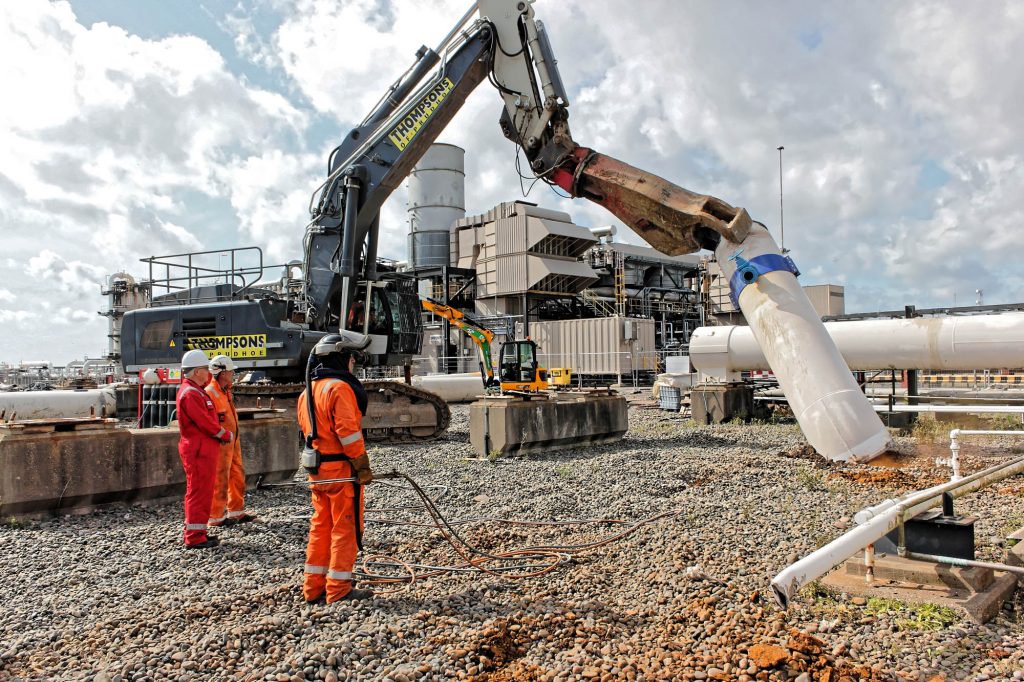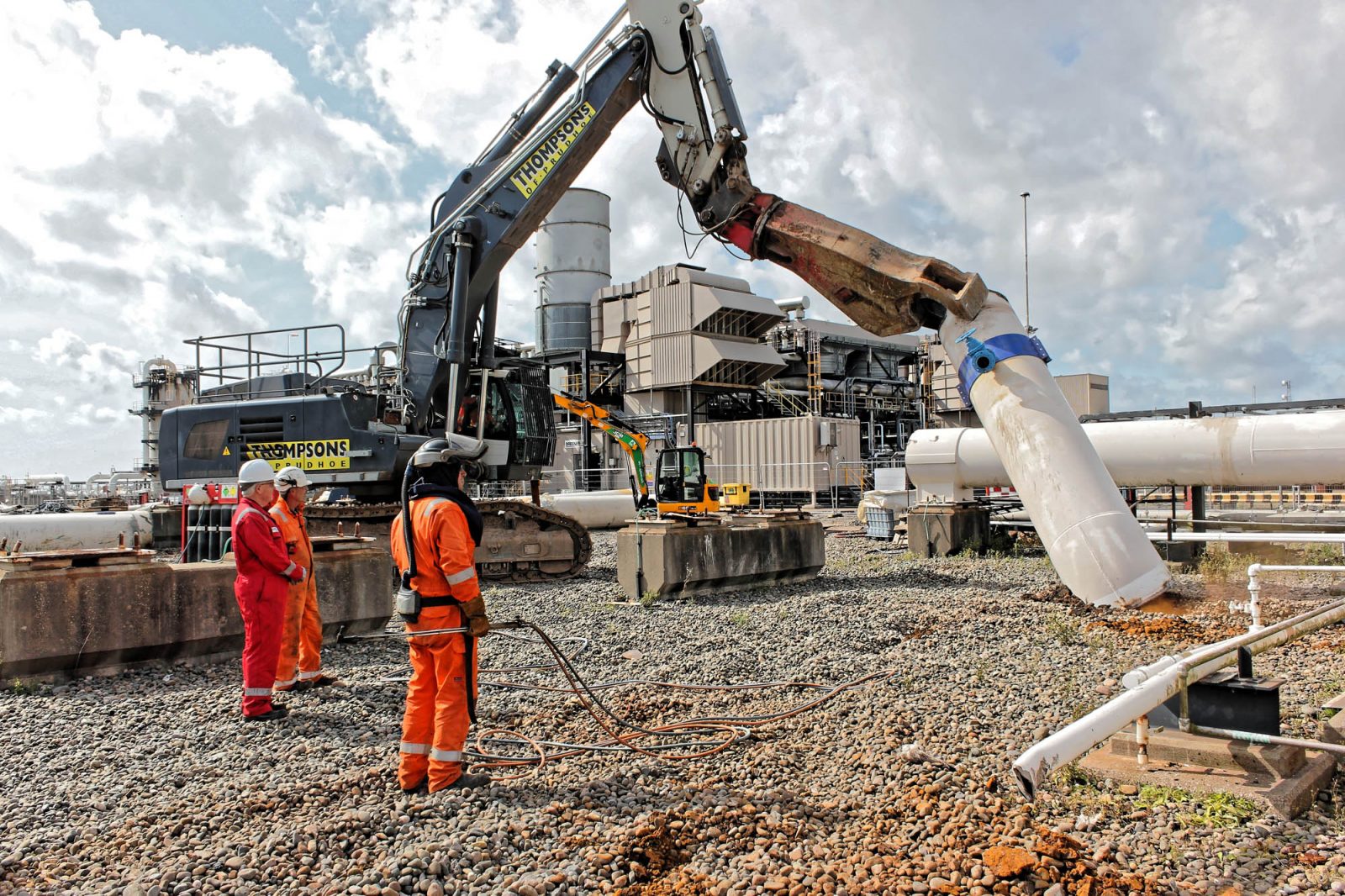Demolition is a large task for any experienced contractor to carry out, and before any task can take place, all team members must be made aware of the correct steps of preparation that are needed in order to ensure that all actions and decisions are taken correctly, safely and as efficiently as possible.
Demolition projects take place up and down the UK, whether they be on a large scale for example a Power Station, Chemical Plant or other Industrial Sites, or smaller projects such as your local Shopping Centre, Hospital or Tower Block. Here at Thompsons of Prudhoe, we have earned our title of “Demolition Specialist of the Year”, by having over seventy years of experience in the industry, and today we want to help you with our guide to demolition.
Firstly. What Is Demolition?
Demolition is the science and engineering in safely and efficiently, dismantling of a building and/or man-made structures, in order to utilise the land for further use.

Why Correct Demolition is Crucial
Demolishing a site correctly, safely and efficiently is crucial in order to base solid foundations for the following phase of work. If a mistake is made throughout the process, it could lead to accident, injuries and even death.
You have a number of Health & Safety laws to abide by, and a level of skill and knowledge to uphold before you even think about beginning.
How To Prepare For Demolition…
Where To Start –
Plan The Project
As you would with any brand new project, the first step to a Demolition project getting underway is to efficiently plan out each stage and aspect.
Consider what you will need:
- Permission to Proceed from the Local Authority/Regulators
- A series of QHSE Documentation
- Suitably Qualified and Experienced Workforce
- Appropriately maintained and serviced Plant & Equipment
Communication Is Key
Your second step is to liaise with the authority, business owner and/or landowner of the site in question, before any demolition activity is actioned. There can be several QHSE measures that you need to bear in mind before you get started. These could be;
- Existing Condition of the Land/Building/Structures
- Understanding of the Local Environment (Highways, Footpaths, Surrounding Residents/Neighbours)
- Any Contamination Present? (Asbestos, Mercury, Benzine, Hydrocarbons)
At least this way you are aware of any potential risks or obstacles prior to the project getting underway, so that your team can work together to develop and execution strategy that ensures you are working as safely and efficiently as possible!
Conduct Surveys
Professional surveyors must visit the site prior to ANY work commencing, in order to investigate and translate their skilled findings and understanding of the project and highlight what could be potential risks ahead of construction;
- R&D Survey – An R&D survey is known as A Refurbishment and Demolition survey, which is necessary when an entire / or part of a building is to be refurbished, demolished, removed or dismantled. An R&D survey can be intrusive and therefore should only be carried out when demolition work is planned to go ahead. The report you will receive can detect any traces of asbestos, a full list of all areas thoroughly inspected along with plans and conclusions, to ensure that the project goes ahead as streamlined and safely as possible.
- Dilapidation Survey – A Dilapidation survey is performed to assess the condition of a building, structure or property. It will indicate any damage or future concerns to the existing condition or structure of the building, structure or property. The Surveyors skills and knowledge will also help the Demolition Contractor derive a method and sequence that is Safe and Effective.
*Top Tip: If you are a new owner to a particular site, a Dilapidation survey can help to give you an insight to any maintenance work that may or not have ever been carried out prior to you taking over the lease/ownership.
An example of what work may be instructed following your report could be the removal of partitions and ceilings, mechanical and electrical repairs, plumbing and draining works and/or roof repair.
Meet Regulations and Health & Safety Laws
The law states that all demolition, dismantling and structural alteration work must be planned and carried out effectively to prevent danger or harm by any sole person working on the task.
Demolition work should only be carried out by those workers with the relevant skills, knowledge and experience to do so. An untrained worker could be at risk from one or more of the following dangers;
- Falling from Height
- Uncontrolled Collapses
- Interaction with ‘live’ Services
- Being Exposed to Hazardous materials
- Exposure to Fire
The Construction (Design and Management) Regulations 2015 (CDM) helps you to improve the Health & Safety of your work by the following;
- Plan work sensibly – All risks are managed from start to finish
- Enlist the right workers for the cause
- Cooperate with others
- Ensure that you withhold the correct information regarding any potential risks and know how they are being managed
- Communicate with your project team members
What The Team Needs To Know
Approach any demolition project with a system for each team member to manage their own responsibility in order for the work to run as smoothly as possible. The following responsibilities that must be covered, referring to Health & Safety are as follows:
- The client in question (business owner, landowner, local authority) must appoint duty to a team with the relevant skills, knowledge and experience, where they are capable of the size of the project in hand and have the correct resources to aid the work
- The client and Principal Designer must provide contractors with the pre-construction information received from the surveys mentioned above
- Principal Designers must plan, manage and monitor Health & Safety issues before any demolition work begins, to hand over as much vital information as needed and keep the team as safe as possible
- Principal Contractors must plan, manage, monitor and coordinate Health & Safety regulations throughout the demolition work
- Site Managers must ensure that all workers are supervised and following safe working practices and regulations
- Site workers and subcontractors (if required) must follow instructions given by those in charge of the workflow
Contact Thompsons Today…
You should always seek professional, skilled support throughout any stage of a demolition project. With our advice and leading services, we can assist you to make sure that the work is completed in the safest manner and to the highest possible quality. Our specialist team withholds a fantastic reputation when it comes to completing demolition work in the North East and nationwide. Give us a call today to discuss the details of your project and let us help you!




